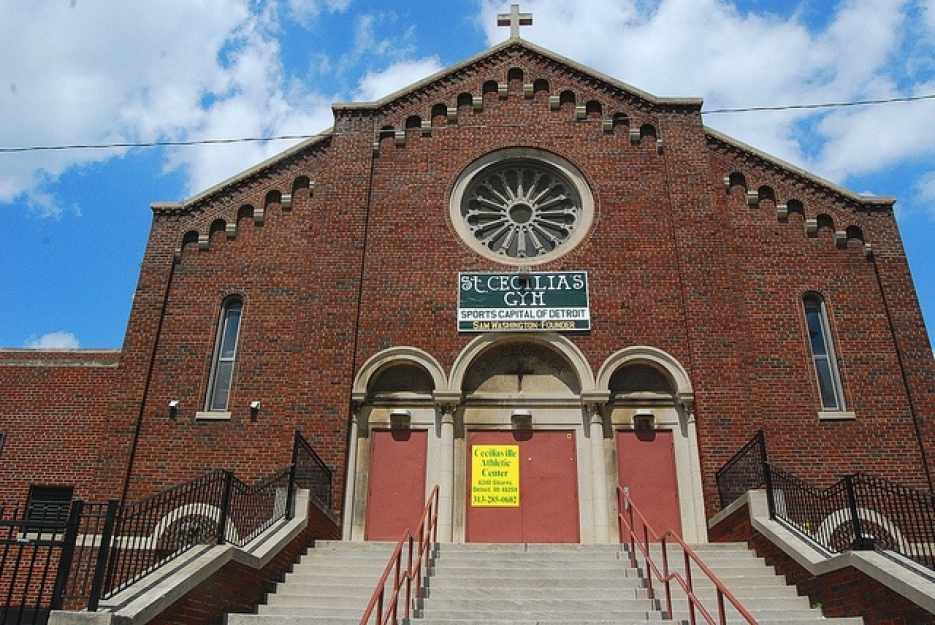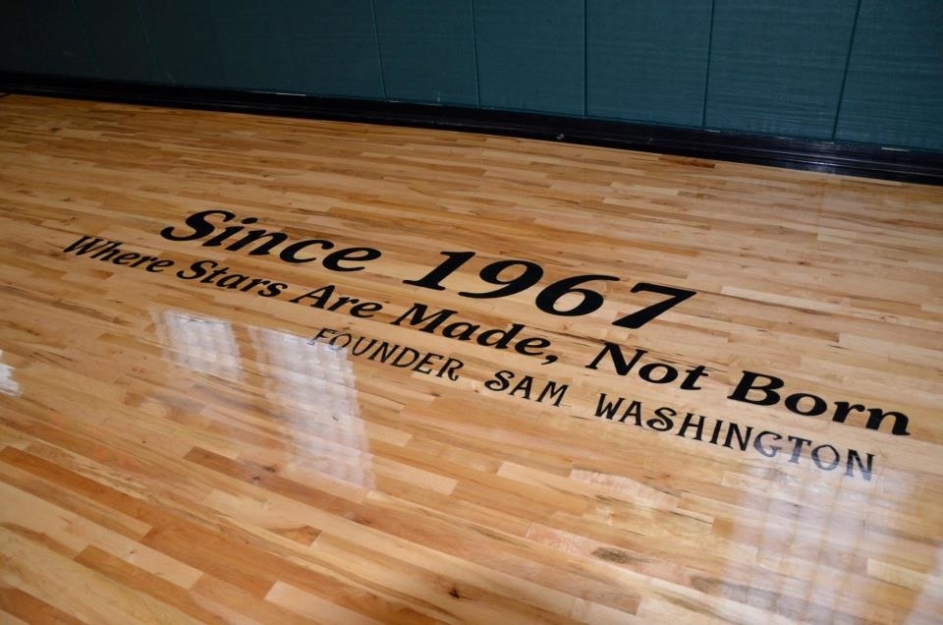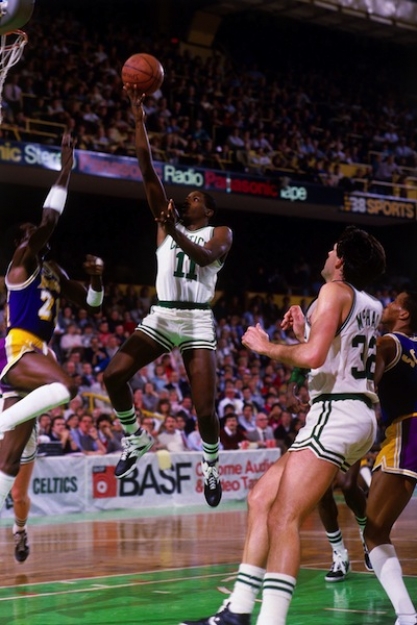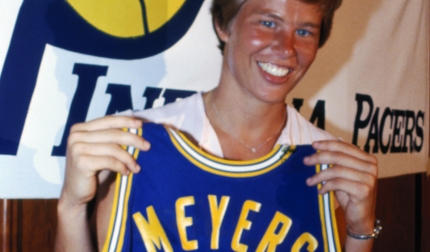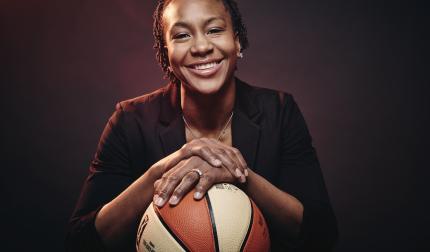Near the Jeffries Freeway in West Detroit, an aging red-brick building is sometimes thought to be a chapel at first sight. A glimpse inside reveals a basketball court that most find to have a bit more spring to it than expected.
The quarters are cramped—one side of the court has its boundary marked with a wall. Bleachers creep within inches of the playing area. And with no air conditioning, temperatures easily register into the triple-digits in August.
The green sign reads “St. Cecilia's Gym” in thin white letters over the opening archway, but players native to the area often use their own names accordingly: The Sanctuary. The Temple. The Jewel of Michigan Basketball. The Mecca.
Mecca may be the best nickname. It describes the obligation that every Detroit basketball player of relevance feels to make a pilgrimage to the old gym and test their abilities—from run-of-the-mill junior-high standouts to college All-Americans to NBA veterans.
“Your game wasn't proven until you were able to prove it at St. Cecilia,” said Jalen Rose, who attended St. Cecilia's grade school before attending the University of Michigan and embarking on a 14-year NBA career.
It’s not surprising that a city with a basketball scene as fiercely as competitive as Detroit's used a gym with many of it’s own challenges as its proving ground. “When I first arrived at St. Cecilia's, I realized it wasn't about being state of the art,” said Sam Vincent, Michigan’s “Mr. Basketball” in 1982, and a member of a Boston Celtics’ championship team. “It was about history.”
Building the legend
As with most success stories, at the center of St. Cecilia's is a singularly determined individual. In this case, it was a gym teacher and athletic director named Sam Washington, who in 1967 saw his hometown troubled by racial tension and riots, and his gym lying empty throughout the summer. Washington tried to remedy both situations.
Before long, opening up the doors to kids around the neighborhood ensured Washington a full gym and a fledgling summer league, but St. Cecilia's sterling reputation leaped off the back of a 1974 contract dispute between the Detroit Pistons and their Hall of Fame guard Dave Bing.
Locked out of his normal practice space for the three weeks of negotiations, Bing came to the gym his old friend Sam Washington had been pushing for him to be a part of—St. Cecilia's—to keep his game fresh throughout the holdout. Washington, recognizing the opportunity for promotion, had never made any secret about Bing choosing his gym for his workouts, but took it to another level to secure extra funding for his passion project.
As Bing practiced at the gym, steadily racking up fines from the Pistons, Washington approached Bing to ask what his team planned to do with the money. Bing didn't know the answer. While the Pistons typically donated the proceeds from player fines to an outside cause, they probably did not expect Washington’s idea.
“I don't know how my dad did it.” Sam Washington Jr. says. “But he got the Pistons to donate the money they were taking from Dave Bing to St. Cecilia's so they could get a new floor and things of that nature.”
The first teammate Dave Bing was able to bring down to try out St. Cecilia's springy new floors was a rookie by the name of Jimmy Walker—Jalen Rose’s late father, who had just been selected first overall in the draft. After that, neither Bing nor Sam Washington had to twist a single arm to get a local palyer to test his game there.
“It was word of mouth,” says Bing, now the mayor of Detroit. “I didn't see Sam doing a lot of outreach.”
In an era where players were left to their own devices to maintain their skills over the offseason, the patronage of Bing and Walker was enough to bring along fellow Pistons stars to train during the summer, including Hall of Famers like Dave DeBusschere and Bob Lanier.
Once St. Cecilia's could start boasting NBA players in its summer leagues, it quickly became a place that Detroit players—from well-paid future Hall of Famers to unemployed street prodigies—could go to find elite competition.
Despite living a fair distance away in Ann Arbor, where he attended Pioneer High School, the rumor of professional players hanging around St. Cecilia's lured a high school-aged Bob Elliott to the gym. Elliott would later go on to earn All-American honors at Arizona and play three seasons for the New Jersey Nets. Alongside his friend Tony Dungy—yes, that Tony Dungy—Elliott recalls getting more than he bargained for on his first trip.
“We went down early to watch those guys play. We looked, and Bob Lanier walked into the gym and we were like 'Alright, we're going to see Bob Lanier play!' Then it came time for our game and we were warming up and I looked at the other end of the floor and there was Bob Lanier. Yeah, we were going to see him, alright!”
A place where only the game mattered
As much as St. Cecilia's existed as a forum for Michigan junior high and high school talent to converge and gain attention from coaches and recruiters, there were no age requirements or professional qualifications needed.
“Having played in the NBA … All of us NBA [veterans] know that many of the best ballplayers in the world are not in the NBA, for whatever reason,” Elliott said. “But in St. Cecilia, you're getting everybody there.”
The parking lots overflowed with cars—and players waiting in line—as word of the the best competition in the state spread. Players stepped into the red-brick hothouse lined with packed bleachers that leered over the court like hanging tree branches, knowing that they had the opportunity to prove themselves against the stars. Or be memorably embarrassed. The decision to step onto St. Cecilia's court was not made lightly.
Before Willie Burton starred at the University of Minnesota, became a top-10 draft pick and played in the NBA for eight seasons, he made a point of honing his game and reputation around the other playgrounds and gyms of Detroit. He didn't dare face the challenge of St. Cecilia before the time was right. “You have to go to St. Cecilia's when you're ready,” Burton said. “You don't just walk up there like 'Ok, let's play some basketball,' you will get killed.”
Then, and especially now, other local gyms offered more comfortable conditions than St. Cecilia's. But Washington, as well as players, embraced the inescapable sweltering heat as just another crucible to bear when trying to hang with the top competition in the state.
“It would be more than hot,” Elliott said. “Why shower? You couldn't shower. Your body would just keep perspiring after games.”
And how did players adjust to such conditions? “Shoot, you play,” Elliott said.
Not only did they play, but in a fast-break, high-flying, showy style that would have been grueling even in a controlled climate. Vincent summed up the style as “Fast-break, fast-paced, hot, competitive, physical, lot of fouls, no calls.”
But there was a method to the madness. As much as the likes of Derrick Coleman, B.J. Armstrong, Chris Webber, Glen Rice, Voshon Leonard and members of the Detroit Pistons milling about turned the court into a performance stage, tough defense and basketball IQ were emphasized. As much as tough play and intensity ruled over the gym, the professionalism of the refereeing on-hand graduated alongside St. Cecilia's rising profile.
Jalen Rose, whose favorite St. Cecilia's memory is a game he was ejected from for fighting Steve Smith—a man he acknowledged as an idol—turned around and dismissed any notions of the Detroit hoops sanctuary being a home to unkempt streetball.
“You had to be a well-rounded player,” Rose said. “It wasn't about just getting it in the hoop, it was about working on your game and trying to take it to the next level. We had so many players who were having success in high school, success in college, success in the pros. It was almost like an assembly line of terrific players that would continue to come through St. Cecilia's.”
Sam Washington's handiwork
Any creation reflects upon its artist, but for a gym that opened its doors to the top, but also very young and strong-minded players from all across Michigan for decades, St. Cecilia's remaining a product of Washington's vision required his constant attention and maintenance of the court and its surroundings.
“He had his whistle; he had his striped shirt,” Bing said. “You knew who he was. He walked inside the gym; he walked outside the gym.”
Located in a rough part of a tough city and host to heated games played for city and regional pride, there was a lot of potential for violence. Yet incidents were kept to a minimum, to the degree where out-of-towners like Vincent, who came there from Lansing, felt comfortable making the trip out.
For some, the secret to St. Cecilia's success was the pure entertainment value, the undeniable quality of and focus on the basketball that pushed everything else to the background.
“People weren't worried about their problems or anything that was going on,” Burton said, “They were just seeing some basketball players doing some phenomenal things.”
Rose had a less ethereal idea for why extra-curricular activities were kept to a minimum.
“Sam Washington sat at that door. You would have thought he was a Navy SEAL the way he was respected in that community.”
Washington's positioning at the fountainhead of Detroit basketball made him an authoritative voice in the region. College coaches who wanted to see a player knew to reach out to him, and in turn his word was said to be enough to secure a scholarship over the phone, sight unseen.
Burton, despite never having a substantial relationship with him, still remembers a standalone moment where Washington acknowledged his potential.
“That was like the President of the United States giving you recognition,” Burton said.
Washington was supportive of players, but his praise was not given idly. Sometimes, it was intentionally withheld, and in some cases, his best players got the hardest treatment. When Jalen Rose— whom Washington refused to call 'Jalen' until “he made a name for himself”—was still a grade school student at St. Cecilia's, Washington seized a moment where he caught the youngster goofing off to shock him with his first ever glimpses of his estranged biological father.
“He took me downstairs and he dusted off his old projector, I remember him wiping the dust off it, there was literally dust on this thing. And he showed my biological father (Walker) doing the spin dribble, being a big guard, putting in work, knocking down jumpers, and said 'That's what you could potentially be, if you stop goofing around, Rose.'”
Keeping St. Cecilia's alive
Washington never did address Rose by his first name. He died of a stroke in 1988 at just 54 years of age.
“Kids think, 'My dad's invincible, he's going to be around forever,'” Washington Jr. said. At the time of his father's passing, Washington Jr. was a young man trying to make his own way in Philadelphia. Now after his siblings had their turns heading up the gym, he's the Executive Director of the facility.
“I don't want anyone else running it,” Washington, Jr. said.
And Washington Jr. is not coasting on the name of his father. The challenges he faces are entirely different. The actual St. Cecilia's school closed in 2010, taking with it critical funds that used to be received from the church, and Jalen Rose's efforts to open a charter school in the space fell through as well. College recruiting rules have reduced the amount of influence figures like Washington can wield and the game has simply spread out, taking Detroit's utter dominance of the Michigan basketball scene with it. St. Cecilia's is still respected—college stars Trey Burke and Derrick Nix made their way down to the gym in the past year—but there are other gyms as well, and other ways to be seen.
Sam Jr. has kept the place looking pretty spiffy. A new floor was added two years ago. A mural of Sam Washington, Sr. and a Hall of Fame, which includes nearly 300 names, make up the interior. The phrase “Where stars are made, not born,” is painted onto the hardwood.
Landmark status exists as a possibility down the road, but Washington Jr. realizes that the key to keep St. Cecilia's alive is engaging its past, reaching out to gaudy names that dot the list of St. Cecilia's alumni and to keep them coming out for fundraising events to help the place that helped them stay out of trouble growing up, take their game to the next level and build the confidence they needed to succeed at any stage. “I've got a sales background,” Washington Jr. said, “The word 'no' means nothing to me.”
The hard sell has its uses, but many of these guys find themselves coming back without prodding. What would have been an exciting prep lineup 20 years ago now makes for a hard-fought battle in the leagues made up of retired players that St. Cecilia's hosts regularly now.
“They're always going to be intense,” Burton said of the games he frequents along with Jalen Rose, Voshon Lenard and others. “Guys' pride is there. We can't move the same, we can't jump as high, but no one wants to lose.”
But do the fans still pack the hot little red brick gym to see it?
“Oh yeah,” Burton said, “The parking lot is full.”
To keep up with more NBA greats, visit LegendsofBasketball.com.


